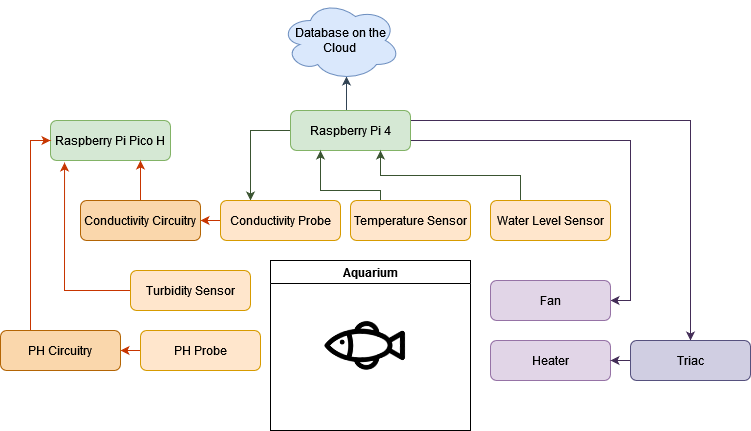The motivation behind this project was to provide aquarium owners with a useful tool to facilitate the maintenance of their aquariums. The said tool could also be used to observe the effect of different food and medication on the water quality in a tank. Moreover, the proposed system would allow users to monitor the water quality of their aquarium remotely. It would also be capable of triggering actuators to stabilise the condition of the water in the tank, in response to the readings obtained from the sensors.
The proposed monitoring system was designed to include a number of different sensors, each being sensitive to different parameters found in the water, namely: water temperature, pH level, conductivity, turbidity and the water level ‒ all of which being important properties that would affect the fish living in the tank. Each sensor was connected to its conditioning circuitry, which would adjust the outputs to match the input range accepted by the internet of things (IoT) device. This is a type of low-power computing device that has the ability to connect wirelessly to the internet.
The temperature sensor used was a waterproof digital sensor, meaning that its output could be understood directly by the IoT device that was connected directly to it. The water-level sensor was also a digital sensor connected in a similar manner.
The turbidity sensor measured the clarity or otherwise of the water in the tank. This sensor was set to issue an analog signal, which the IoT device could not directly interpret. A small microcontroller was also used; this converted the analogue signals into digital signals to enable the IoT device to read them. This was achieved through analogue-to-digital converter chips.
The pH probe, which was installed to assess whether the water was acidic or alkaline, was first connected to a circuit to amplify the signal. The conductivity sensor served the purpose of measuring impurities in the water. To function, the probe was given an alternating signal from the IoT device and the output was then amplified. The amplified outputs from the above sensors were converted to digital format by the above-mentioned microcontroller.
The IoT device was used to collect the data gathered from the individual sensors, and to process them from raw data into their proper units. All this data was then collected into a packet and transmitted to a database via the internet, where the changes in water quality could be displayed in the form of graphs that were made available online on the cloud.
When certain parameters exceeded or fell below a certain threshold, such as temperature falling outside the ideal range, the IoT device would enable the respective actuators to stabilise the condition in the tank. For example, if the temperature were to increase significantly, the IoT device would turn on the fan to cool the water. The actuator would then switch off when the temperature would return into a stable range.

Figure 1. Block diagram of the smart aquarium monitoring system
Student: Gillian Anne Gatt
Supervisor: Prof. Ivan Grech
